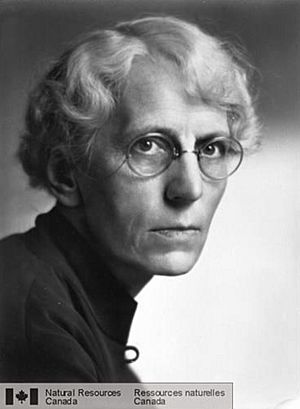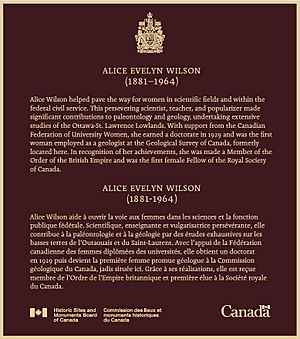Alice Wilson facts for kids
Quick facts for kids
Alice Wilson
|
|
|---|---|
 |
|
| Born | August 26, 1881 Cobourg, Ontario, Canada
|
| Died | April 15, 1964 (aged 82) Ottawa, Ontario, Canada
|
| Alma mater | University of Chicago and Victoria University, Toronto |
| Known for | First female geologist in Canada |
| Scientific career | |
| Fields | Geologist |
| Institutions | Geological Survey of Canada |
Alice Evelyn Wilson (born August 26, 1881 – died April 15, 1964) was a very important Canadian scientist. She was the first female geologist in Canada. Geologists study the Earth, including rocks, fossils, and how the planet changes over time. Alice Wilson's studies of rocks and fossils in the Ottawa area, done between 1913 and 1963, are still highly respected today.
Contents
Early Life and Interests
Alice Wilson was born in Cobourg, Ontario, in 1881. Her father, Dr. John Wilson, was a professor. From a young age, Alice loved being outdoors. She often went canoeing and camping with her father and two brothers. These trips helped her discover her interest in fossils and geology. Being outside also helped her with her health, which was not always strong.
Alice came from a family that valued learning. Her father was a doctor, and her brothers became experts in geology and mathematics. This meant that studying and seeking scientific knowledge was always encouraged in her home.
Education Journey
In 1901, Alice started studying modern languages and history at Victoria College in Toronto. She first planned to become a teacher. However, she had to stop her studies before finishing her last year because of health problems. She eventually completed her degree many years later, in 1911.
Even though she was ready to start a PhD in 1915, Alice faced a big challenge. The Geological Survey of Canada (GSC), where she worked, kept denying her paid time off to study. This was unfair because other people at the GSC were getting paid leave at the time.
Alice's boss, Edward M. Kindle, supported her and wanted her to get her PhD. But other leaders at the GSC were not as helpful. For seven years, Alice kept trying. Finally, in 1926, she won a scholarship from the Canadian Federation of University Women (CFUW). Even then, the GSC tried to stop her leave. After the CFUW pushed for her, Alice was finally allowed to go. She graduated in 1929, at the age of 48, from the University of Chicago with a doctorate degree in geology.
Her Amazing Career
Alice Wilson began her career in 1907 at the University of Toronto museum, working with minerals. She did this even before she had finished her degree. In 1909, she became an assistant at the Victoria Memorial Museum. Later, she got a temporary job as a clerk at the Geological Survey of Canada (GSC), which was located at the Victoria Memorial Museum in Ottawa.
She was asked to translate part of a German book about paleontology (the study of fossils) into English. Her colleague, Percy Raymond, also helped her get a leave of absence from the GSC so she could finish her first degree, which she did in 1910. In 1911, she returned and was given a permanent job at the GSC. It took until 1970 for other women to get the same kind of permanent position there.
Alice wrote two articles that described new species of animals. However, after that, she found it hard to be included in her male colleagues' work.
During the First World War (1916), the Victoria Memorial Museum was closed and used as a wartime parliament building. Alice used her own money to fund her projects during this time. She studied marine biology in New York. She also helped with the war effort at home, joining a group similar to the Women's Land Army. When the war ended in 1920, Alice returned to the Victoria Memorial Museum as an Assistant Paleontologist. She was later promoted to associate geologist in 1940.
While working at the GSC, women were not allowed to do fieldwork with men. So, Alice found her own way. She did fieldwork at local sites around the Ottawa area. She ended up mapping over 14,000 square kilometers of the Ottawa St. Lawrence Lowlands all by herself! For 50 years, she explored the area on foot, by bicycle, and later by car.
The GSC published her fieldwork results in 1946. Her book, Geology of the St. Lawrence Lowland, Ontario and Quebec, was the first major geology book about that area. Besides discussing the geology, Alice also wrote about the area's natural resources, like building stone, sand, gravel, and drinking water. Her research on the layers of rock (called stratigraphy) and invertebrate fossils from the Paleozoic era in eastern Canada was very important. However, her contributions were not fully recognized until after she retired.
In Ontario, she focused on invertebrate fossils from the Ordovician period, especially in the Ottawa Valley. She also studied Ordovician animals in the Rocky Mountains and the Arctic. During the Great Depression, Alice had to change her focus to Devonian rocks. This was because there was a growing need for petroleum in Western Canada. One of her jobs was to identify and sort all Paleozoic invertebrates for study. Because of her work, the National Type Collection of fossils was created. This is a collection of fossils used as a reference around the world.
From 1948 to 1958, Alice taught paleontology at Carleton College (now Carleton University). Carleton recognized her as both a great geologist and an inspiring teacher, giving her an honorary degree in 1960. Alice also wanted to share geology with more people. She wrote a children's book called The Earth Beneath our Feet. Its goal was to encourage more people to learn about and become interested in geology.
Alice Wilson's work on the geology and paleontology around Cornwall, Ontario and the St. Lawrence lowlands was very important for building the St. Lawrence Seaway in 1954.
Alice became a respected member of the GSC. She guided many young geologists through her lectures, field trips, publications, and museum exhibits. However, her colleagues did not call her "Dr. Wilson" until 1945, which was 16 years after she earned her PhD. She retired two years later, at age 65, as required by law. Even though she retired, five new people were needed to do the same amount of work she had done! Alice kept her office at the GSC and continued her work without pay until she passed away in 1964.
Awards and Recognition
Alice Wilson achieved many "firsts" for women in science:
- She was the first woman geologist hired by the Geological Survey of Canada (in 1909).
- She was one of the first two women elected as Fellows of The Royal Canadian Geographical Society (in 1930).
- She was the first Canadian woman to be accepted into the Geological Society of America (in 1936).
- She was the first female Fellow of the Royal Society of Canada (in 1938).
In 1935, the Canadian government wanted to honor a woman in federal public service. Alice Wilson was chosen to become a Member of the Order of the British Empire, a special award from the British King or Queen.
In 1991, the Royal Society of Canada created the Alice Wilson Awards. These awards help support new women scholars. In 2005, Alice Wilson was added to the Canadian Science and Engineering Hall of Fame.
On October 18, 2018, the Government of Canada placed a special plaque at the Canadian Museum of Nature. This plaque recognizes Alice Wilson as a "person of national historic significance."
Selected Publications
- 1926. An upper Ordovician Fauna from the Rocky mountains, British Columbia. Bulletin of the Geological Survey of Canada
- 1946: Geology of the Ottawa-St. Lawrence lowland, Ontario and Quebec. E. sils: Ottawa formation, Ottawa-St. Lawrence Valley. E. Cloutier, Ottawa
- 1951: Gastropoda and Conularida of the Ottawa formation of the Ottawa-St. Lawrence lowland. E. Cloutier, Ottawa
See also
 In Spanish: Alice Wilson para niños
In Spanish: Alice Wilson para niños


